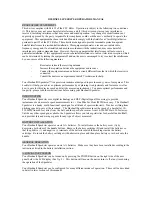
15
TK-6110
CIRCUIT DESCRIPTION
4-4. Driver and Final Power amplifier Circuits
The transmit signal is generated by the TX mixer (Q503).
The transmit signal obtained from the buffer amplifier Q1
and Q2, is amplified by Q3 to approximately 30dBm. This
amplified signal is amplified by Q4 and Q5 to approximately
8W, and this signal is passed to the final stage.
The RF power amplifier consists of transistor (Q6 and Q7)
and is capable of roducing up to 70W of RF power.
4-5. Transmit/Receive Switching Circuit
The final output signal is passed through a transmit/re-
ceive switching circuit (K1) before it is passed to the an-
tenna terminal.
4-6. Automatic Power Control, Circuit and Transmitter
The APC circuit consists of an RF level detector, an ex-
citer control section and a temperature sensing circuit. The
RF level detector senses the forward and reflected power.
The transmitter output power is kept constant by the exciter
control circuit which monitors the forward power and regu-
lates the supply voltage applied to the exciter section.
If the antenna load becomes abnormal, the reflected
power increases, causing the exciter control circuit to re-
duce the supply voltage to the exciter. In case of an abnor-
mal temperature rise in the power amplifier section, the
temperature sensing circuit detects this condition and send
the information to the APC circuit. These actions reduce the
transmitter output power to a safe operating level.
TX
mixer
Q503
RF
amp
Q1
RF
amp
Q2
LPF
Predrive
amp
Q3
Drive
amp
Q4
Drive
amp
Q5
RF power
amp
Q6
TX/RX
ANT SW
K1
RF power
amp
Q7
ANT
Fig. 6 Drive and final amplifier
PDAT,PCLK,LE
TCXO
LPF
LPF
VCO2
VCO1
BUFF
BUFF
BUFF
SW
BUFF
CPU
SW
16.8MHz
UL
Dual PLL
8TB/8R
8TB/8R
TX
local 1
RX
local 1
TX
local 2
RX
local 2
MOD/TONE
Fig. 7
PLL block diagram
5. PLL Frequency Synthesizer
The frequency synthesizer consists of the VCXO (X501),
VCO (L517), PLL IC (IC501) and buffer amplifiers.
The VCXO generates 16.8MHz reference frequency. The
frequency stability is within
±
5.0ppm (temperature range of
–30 to +60
°
C). The output of the VCXO is applied to pin 8 of
the PLL IC.
VCO (L517) has 2 internal VCOs. One for the 1st local
oscillator (K : 158.25~166.005MHz, K2 : 163.55~179.005
MHz) and another one for the 2nd local oscillator
(129.005MHz). Each output is connected to a dual PLL IC
(IC501).
VCO1 oscillates at K : 158.705~166.005MHz, K2 :
164.005~179.005MHz during transmission and it oscillates
at K : 158.25~165.55MHz, K2 : 163.55~178.55MHz during
reception.
VCO2 oscillates at 129.005MHz during both reception
and transmission. However, the oscillated signal is modu-
lated during transmission. Each PLL circuit has LPFs and
buffer amplifiers.
The output of VCO1 goes through the buffer amplifier,
then the output is switched either for the 1st local oscillator
circuit of the receiver or TX mixer.
The output of VCO2 goes through the buffer amplifier,
then the output is switched either for the 2nd local oscillator
circuit of the receiver or TX mixer.
















































